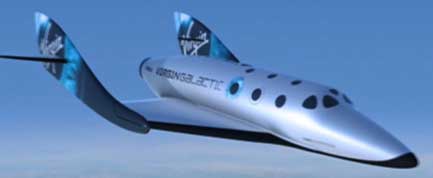New Climate Change Worry: Space Tourism Soot

Humans’ attempts to visit space may not be good for the folks back home, according to a new study that finds soot emitted by space tourism rockets could significantly contribute to global climate change in coming decades.
The researchers assumed that a fast-growing suborbital space tourism market will develop over the next decade, and they examined the climate impact of soot and carbon dioxide emissions from 1,000 suborbital rocket flights per year, the approximate number advertised in recent materials promoting space tourism.
"Rockets are the only direct source of human-produced compounds above about 14 miles (22.5 kilometers), and so it is important to understand how their exhaust affects the atmosphere," said the study's chief researcher, Martin Ross of The Aerospace Corp. in El Segundo, Calif.
He and his colleagues describe their findings in a scientific paper that has been accepted for publication in Geophysical Research Letters.
A layer of soot
According to the study, soot particles emitted by the proposed fleet of space tourism rockets would accumulate at about 25 miles (40 km) altitude, three times higher than the altitude of airline traffic. Unlike soot from jets or coal power plants, which is injected lower in the atmosphere and falls to earth within weeks, the particles created by rockets remain in the atmosphere for years, efficiently absorbing sunlight that would otherwise reach the Earth's surface. [Infographic: Earth's Atmosphere Top to Bottom]
The result is a global pattern of change, according to researcher Michael Mills of the National Center for Atmospheric Research (NCAR) in Boulder, Colo.
Get the world’s most fascinating discoveries delivered straight to your inbox.
"The response of the climate system to a relatively small input of black carbon is surprising," Mills said in a statement. "Our results show particular climate system sensitivity to the type of particles that rockets emit."
Using a computer model of the Earth's atmosphere, the researchers discovered that beneath the predicted layer of soot, the Earth's surface would cool by as much as 1.2 degrees Fahrenheit (0.7 degrees Celsius). Antarctica would warm by 1.5 degrees F (0.8 degrees C).
Meanwhile, equatorial regions could lose about 1 percent of their ozone, while the poles could gain 10 percent. The global effect would be an increase in the amount of solar energy absorbed by the Earth's atmosphere. That means the soot from the rockets contributes to atmospheric heating at a rate higher than the carbon dioxide from those same rockets.
An earlier study by Ross, published in March 2009 in the journal Astrophysics, found that rocket emissions are particularly harmful to the ozone because they're injected directly into the stratosphere where the ozone layer resides.
Considering black carbon
The researchers based their predictions on business plans for suborbital space travel in the year 2020, Ross said. The current global fleet of hydrocarbon-fueled orbital rockets emits about one-tenth of the soot assumed in the study.
"Climate impact assessments of suborbital and orbital rockets must consider black carbon emissions, or else they ignore the most significant part of the total climate impact from rockets," Ross said. "This includes existing assessments that may need to be brought up to date."



